
Five Reasons to Go Electric and stay Electric
With more and more Americans riding personal electric vehicles every day, the market is exploding and there's some good reasons why. Personal Electric Vehicles are not a new thing, they have been around since the mid-19th Century. However, in the past few years, there has been a significant rise in the use of personal electric vehicles. More and more people are opting for some form of personal electric vehicle as an alternative transportation method to cars and mass transit. Be it an e-bike, e-skateboard or a CycleBoard, the market continues to grow as people find convenience and value in these vehicles. Why Go Electric? 1. Enhanced Efficiency Personal Electric Vehicles are not a new thing, they have been around since the mid-19th Century. However, in the past few years, there has been a significant rise in the use of personal electric vehicles. More and more people are opting for some form of personal electric vehicle as an alternative transportation method to cars and mass transit. Be it an e-bike, e-skateboard or a CycleBoard, the market continues to grow as people find convenience and value in these vehicles. The X-Quad 3000 offers a cost-effective solution for daily commutes and short trips. With its electric powertrain, you can reduce fuel expenses and maintenance costs associated with conventional vehicles. Its impressive range of up to 50 miles on a single charge ensures you can reach your destination without frequent recharging. 2. Eco-Friendly Transportation Choosing the X-Quad 3000 contributes to a cleaner environment. By emitting zero tailpipe emissions, this electric vehicle helps reduce air pollution and your overall carbon footprint, promoting a healthier planet for future generations. 3. Versatile Performance Designed for both urban and off-road adventures, the X-Quad 3000 features dual 1500W motors (totaling 3000W) and a 4-wheel independent suspension system. This setup provides exceptional stability, agility, and control across various terrains, making it suitable for city streets, trails, and golf courses alike. 4. Golf Course Optimization For golf enthusiasts, the X-Quad 3000 offers a specialized Golf Mode. This mode delivers low-speed, high-torque performance for effortless hill climbing, automatic electronic braking, and includes a custom Golf Bag Mount to transport your clubs conveniently. This feature enhances your golfing experience by allowing smooth navigation across the course. 5. Advanced Safety Features Safety is paramount with the X-Quad 3000. It comes equipped with a powerful 3.5-inch horizontal screen display that provides real-time ride information and includes features such as theft protection and a parameter lock. Additionally, the vehicle boasts a 4-wheel braking system and integrated lighting, ensuring visibility and control in various conditions. Embracing electric transportation with the CycleBoard X-Quad 3000 not only offers personal benefits but also contributes positively to the environment. Its combination of efficiency, eco-friendliness, versatility, and safety makes it a compelling choice for modern mobility needs.
Read More →

How Electric Scooters Work: What Owners Should Know
If you've recently bought an CycleBoard, or are getting ready to pull the trigger, you've probably asked yourself - how does an electric scooter work? These are powered by a motor, and you'll use the acceleration throttle and brake controls located on the handlebars. But if you're a bit more interested in the science behind these, you're in luck. Today, we're going to take a look under the hood of electric scooters so you can gain a better understanding of how they work. We'll talk about the electric motors these are powered by along with how to operate them. Let's begin! How Exactly Do Electric Scooters Work? The electric scooter is gaining popularity as more and more adults realize that these things aren't just for fun anymore. They are a viable means of transportation if you have a shorter commute to and from work. Those living in the city have realized that taking daily taxis or Ubers is too expensive. But, sitting in your own personal car waiting in traffic isn't much better. With a quality electric scooter, though, you can zip around the city with ease - and have fun doing it along the way! With top speeds over 27MPH and ranges up to 50 miles, you can rely on an electric scooter to get you from point A to point B. The best part? Many of these are rated for all-terrain - so you can take them off the beaten path if you see a shortcut. You aren't limited to the street. But, before you get yours on order, you probably want to learn a bit more about what makes the electric scooter tick. Unlike gas-powered scooters and manual kick/push scooters, electric scooters use batteries. You'll have to charge your electric scooter regularly to keep that battery topped off. Then, hop on the electric scooter deck, power it up, and use the handlebar throttle and brakes to stop and go. Turning is easy, too - with Cycleboard electric scooters, you simply lean to turn. We'll talk more about how to actually operate your electric scooter shortly - first, let's pop open the "hood" and take a look at the motor of the electric scooter. A Look Under The Hood At The Electric Motor The operation of an electric scooter is pretty simple. They use batteries - typically, lithium-ion batteries. You'll find different types of rechargeable batteries from different manufacturers/models. For example - the X-Quad implement a massive 60V 1800wh battery - whereas most smaller street scooters implement a much smaller voltage battery. Let's look a bit deeper at the internal components of our X-Quad battery: The X-Quad's battery pack contains lithium-ion cells that contribute to 1800Wh of energy. To get a bit more specific, these batteries are built using top-of-the-line LG and Samsung 21700 Lithium Ion cells. These are among the most energy-dense and reliable lithium-ion battery cells on the market. These rechargeable batteries send power to the electric motor. This is what actually propels the electric scooter forward. In the case of Cycleboard X-Quad electric scooter, you'll find dual 1500w brushless silent rear hub motors. These types of motor is virtually silent, and yet provides substantial torque. This allows for quick acceleration, off-road conquering, and hill-climbing. What About Brakes? Now that you know what propels the X-Quad forward, let's talk about what slows it down and brings it to a stop. Everyone is concerned with speed when shopping for their electric scooter - but braking is just as important, if not more so. Being able to quickly come to a complete stop is something you should not overlook. So, how do electric scooter brakes work? Again - this will vary depending on the specific manufacturer and model you go with. But, we'll use our Cycleboard X-Quad as an example once again. The braking system here implements a combination of electronic and hydraulic braking. This slows the electric hub motor down while adding stopping power through a hydraulic disc brake. The disc brake is 165mm - which is fairly large for an e-scooter. We do this to ensure you have the ability to stop on a dime. It also include front drum brakes, that will slow you down at a gradual and much less immediate pace to insure that any rider can ride without concern of flipping over the handlebars. Which is a concern among many who ride products with all hydraulic brake systems. But the electric braking alone will stop your scooter, but the adding the hydraulic brake system and drum brakes adds safety and performance to our scooters. To activate the hydraulic and electric brake system, you simply pull the brake lever on the handlebar. Other Components That Make An Electric Scooter Work Stopping and going are the main mechanisms behind electric scooters. But these two systems are married to a myriad of other components that make your electric scooter work. Here are a few other aspects that make an electric scooter work: Wheels - there are two types of wheels you'll find on most electric scooters: air-filled pneumatic tires (great for all-terrain use) or solid wheels. These days, you'll seldom find solid wheels because they don't provide the comfort, safety, or performance most riders need. The bigger the wheels, the more performance. While you may be more familiar with the 2-wheel style scooter, 3-wheeled & 4-wheeled electric scooters are rising in popularity. This extra wheels adds a level of stability and performance that the 2-wheeled counterpart cannot match. For example, you could ride these all-terrain scooters on grass if you wanted. Suspension systems: the best e-scooters even come with an intuitive suspension system. This allows for a smooth, comfortable ride. You won't feel the bumps and potholes nearly as much as you would on a stiff scooter. And, this suspension allows you to take your electric scooter off-road, too! Steering systems: the steering system on e-scooters is what allows you to turn left or right. You may be used to physically turning the handlebars on your scooter to make your turns. But this technology is outdated. At Cycleboard, we've engineered a patented steering system that uses advanced lean-to-steer technology that works with the self-centering suspension springs. The scooter moves with you - if you lean to the right, it turns to the right. This creates a unique, instinctive ride, unlike anything you've experienced before. There are other components of electric scooters too - such as the deck (what you stand on), LCD display (shows your speed, mileage, battery levels, etc.), and more. But, the components we've mentioned above are the main players that make electric scooters work. How To Actually Operate Your Electric Scooter Now that you know what makes electric scooters work, how do you work your electric scooter? When you hop on a Cycleboard, it's pretty simple. We even have an entire section of our website dedicated to teaching you how to ride. We're going to quickly provide some recommendations for that first ride, though. Start with the proper gear: All riders should have a helmet and proper footwear. Don't overlook the importance of wearing the right shoes - they should be close-toed. The last thing you want is to step off your board wearing flip-flops and skin your toes, or worse. Find a calm, open space: Don't try and trek through the city streets on your first go. Get comfortable in an empty parking lot first - free of other riders and obstacles. Power up your e-scooter: Don't get on the scooter quite yet - first, power it up and choose your speed level. With a Cycleboard, you can choose from 5 different settings. We recommend you get accustomed to riding, steering, and maneuvering on the lowest setting first. Step on your electric scooter's deck: Give a little push, and use the throttle to propel yourself. Get familiar with the steering system: With traditional electric scooters, you'll physically turn the handlebars. But with a Cycleboard's electric scooter, you'll lean to turn. Shift your weight by dropping your hips in one direction or by putting the weight on your toes/heels. As your weight shifts in one direction, the scooter will turn with you. This will take a bit of getting used to, but within that first ride, you'll begin feeling your confidence soar. Practice braking: To come to a stop, let off the throttle and roll until you stop. Or, for faster stopping, use the handbrake. For a quick intro on how to get riding in just 90 seconds, visit our Learn to Ride page Final Thoughts On How Electric Scooters Work Now, you know how electric off-road scooters work and you know how to operate one. All that's left to do is get out there on yours and give it a try! If you don't have one yet, head over to our site and pick yours out. Trust us - there is nothing quite like riding a Cycleboard. It'll be the most fun you've ever had on three wheels! For more information on how these scooters work and how to use one, check out our help center or other resources in our blog.
Read More →
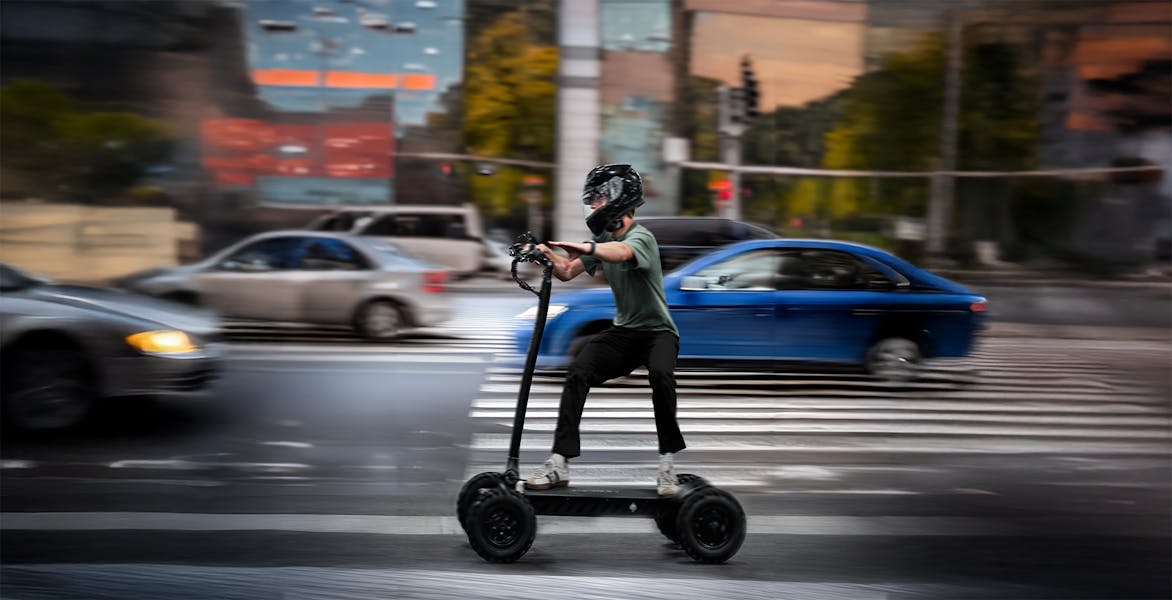
Best Cities in the World for Exploring by Scooter
Exploring a new city on an X-Quad allows you to see more, making it an ideal way to get to know a new destination. If you want a fun, affordable, and environmentally-friendly way to dive into a new culture like a local, grab a CycleBoard for the ultimate urban adventure. Here, we'll highlight some of the best cities in the world to explore on two wheels. Why Exploring on a CycleBoard is the Best Cruising around a new city on an CycleBoard electric scooter gives you a one-of-a-kind perspective you simply can't get from a tour bus, or walking tour plus it’s more eco-friendly. Zooming through the streets lets you cover more ground than walking but you can still see the sights and experience the sounds of an unfamiliar destination. Unlike a cab or rental car, you can stop on a whim to snap pics of cool street art, pop into quirky shops or just take in the atmosphere of a bustling plaza. Scootering also means more freedom and flexibility than public transportation. You get to choose your own adventure and make spontaneous stops whenever the mood strikes. With a scooter, you control the journey. In many cities, scooter rental or rideshare solutions are cheaper than taxis or rental cars, making it a budget-friendly way to explore. And compared to driving, it's better for the environment, as well as giving you access to narrow streets and lanes cars can't even fit down. Whether you’re new to using scooters or a seasoned pro, using them when traveling offers so many advantages. Best Cities for Scootering Lisbon, Portugal With its coastal location, mosaic sidewalks, and Moorish and Baroque architecture, Lisbon is a picturesque city for scootering. The mostly flat terrain makes it easy to zip along the winding, narrow lanes of the Alfama district up to the hilltop Castelo de Sao Jorge. Or ride along the Tagus River to the trendy Belem neighborhood to see the iconic Belem Tower and sample delicious pasteis de nata custard tarts. Lisbon's compact city center is ideal for leisurely scooter rides through lively plazas and charming neighborhoods without having to go too far. With mild weather year-round, Lisbon is perfect for scootering any time of year. Locals embrace scooters and motorcycles as convenient transit around the hilly landscape, which also makes it easier for charging. Amsterdam, Netherlands With its network of bicycle lanes and bike-friendly culture, Amsterdam is arguably one of the most scooter-friendly cities in Europe. Almost everyone gets around on two wheels here, and the city’s compact layout and mostly flat terrain make it ideal for buzzing around by scooter. Cruise along the many picturesque canals passing stately 17th century homes and houseboats; zip through narrow alleyways and charming courtyards in the Jordaan neighborhood, or ride out to the Vondelpark, the perfect spot to pause for a picnic or people watching. Many locals opt for scooters over cars to easily navigate Amsterdam's cobbled streets and avoid parking headaches. With so much of the center city walkable or bikeable, longer journeys are easy to complete via Amsterdam's extensive public transportation network. Copenhagen, Denmark Copenhagen is often considered an incredibly bike-friendly city, so naturally, the Danish capital is ideal for scootering as well. The flat terrain makes scooting effortless as you cruise through historic squares, colorful Nyhavn harbor, and the winding streets of Christiania. Copenhagen's network of cycle tracks and bike lanes makes it very safe and easy to get around, and drivers are accustomed to looking out for two-wheelers for your peace of mind. You'll feel like a local sailing through Copenhagen on a scooter. Many of Copenhagen’s residents commute by bike daily, so why not join them and embrace the freedom of exploring this urban gem of a city on two eco-friendly wheels. Portland, Oregon Portland is one of America's top destinations for scootering around town. With over 500 miles of bike lanes, the infrastructure is designed for safe and easy two-wheeled transit. And a 20 mph speed limit in much of the city center makes roads less intimidating for scooter riders. The city's culture fully embraces scooters, bikes, and other alternative transit options. You'll find wide bike lanes, designated parking areas, and even traffic signals just for cyclists. And drivers tend to be bike-aware, which is great news for those on scooters. With plenty of parks, leafy neighborhoods, and no shortage of coffee shops, Portland is the perfect blend of urban buzz and laid-back Northwest vibe. Discover it all on a breezy scooter ride through one of America's most livable cities, without the need to get around on foot. Taipei, Taiwan Taipei offers a fascinating blend of modern metropolis and traditional Taiwanese culture, but you might also be surprised to learn that it’s a great option for getting around by scooter too. With a comprehensive network of bike lanes and a public bike share system, Taiwan's capital is ideal for scootering around. In fact, the likes of mopeds are already a popular mode of transport for locals. Cruise through bustling urban districts before heading to Taipei's famous night markets like Shilin or Raohe to indulge in Taiwanese street food. Or ride along the Danshui River and watch the sunset behind the historic fisherman's wharf. Taipei's MRT metro system can get you across longer distances to spots like the National Palace Museum or up to Maokong Gondola; from there, you can scooter around neighborhoods like Xinyi with its glittering skyscrapers. With so much delicious food, fascinating history, and natural beauty, Taipei offers endless urban discoveries by scooter. Scooting through a new city allows you to intimately experience the sights, sounds, and spirit of an urban landscape. With the freedom to create your own route and the flexibility to spontaneously stop and explore, a scooter gives you an adventurous, up-close perspective you just can't get from a car or tour bus.
Read More →

Winter Tips for Riding and Storing Your X-Quad 3000
Winter is here, but that doesn’t mean your X-Quad 3000 adventures have to hibernate. Designed to handle off-road terrains and built with durable features, the X-Quad 3000 is ready to tackle snowy trails and frosty conditions. However, winter riding requires a bit of preparation to ensure a smooth, safe experience and keep your board in top condition. Here are some tips for winter riding and storage to get the most out of your X-Quad this season. Winter Riding Tips 1. Gear Up for Traction Snow and ice demand extra grip. Upgrade your X-Quad with the optional 13-inch tires, which provide enhanced traction and stability on slippery surfaces. These tires are designed to tackle uneven, wet, or icy ground with ease, giving you confidence on your winter rides. 2. Protect Against the Elements Moisture and electronics don’t mix. While the X-Quad 3000 is built for rugged conditions, it’s a good idea to protect it further in winter weather. Consider using a light waterproof cover for the display and battery compartments to prevent snow or slush from seeping in. 3. Dress for the Cold Winter winds can cut through even the most exhilarating rides. Layer up with insulated clothing, gloves, and a sturdy jacket. Don’t forget to grab the CycleBoard Hoodie, which is both functional and stylish, keeping you warm while you ride. 4. Adjust Your Riding Style Snowy conditions require a bit more finesse. Reduce your speed and take turns more cautiously to maintain control. Use a wider stance for better balance, and plan your routes to avoid areas with excessive ice or deep snow drifts. 5. Haul Your Gear in Style Planning a winter picnic, snowboarding session, or any other adventure? The CycleBoard rear trailer is perfect for carrying extra gear. Load it up with blankets, snacks, or even snowshoes and head out with everything you need for a day in the snow. Storage Tips for the Off-Season If you’re planning to store your X-Quad 3000 during the colder months, follow these steps to keep it in peak condition: 1. Clean Before You Store Salt, mud, and debris can damage your X-Quad over time. After your last ride, give it a thorough cleaning. Use a damp cloth to wipe down the frame, wheels, and undercarriage. Avoid using high-pressure water, as it can force moisture into sensitive areas. 2. Charge and Store the Battery Lithium-ion batteries perform best when stored properly. Charge your X-Quad’s battery to around 50-70% before storing it. Avoid fully charging or depleting the battery, as this can reduce its lifespan. Store the battery in a cool, dry place to prevent degradation. 3. Protect Your Tires If the X-Quad will be stationary for an extended period, consider elevating it slightly to prevent flat spots on the tires. Alternatively, rotate the tires occasionally to maintain their shape. 4. Store in a Safe Location Choose a storage space that’s dry, cool, and away from direct sunlight. Extreme temperatures can affect both the battery and the materials of your X-Quad. If possible, use a protective cover to keep dust and debris away. 5. Perform a Pre-Ride Check Before taking your X-Quad out of storage for its next adventure, do a quick inspection. Check tire pressure, battery charge, and all electronic components to ensure everything is functioning properly. Keep Riding, All Year Long The X-Quad 3000 is built for adventure in any season, and with these tips, you can keep your rides smooth and your board in excellent condition all winter long. Whether you’re carving through snowy trails or storing your X-Quad for the off-season, a little preparation goes a long way. Looking to gear up for winter? Check out our upgrades and accessories: 13-inch tires for ultimate traction Rear trailer for hauling your winter essentials Cozy CycleBoard Hoodies to keep you warm Don’t let winter slow you down—embrace the season and make the most of your X-Quad adventures!
Read More →

CycleBoard Dealer Spotlight: Power Lodge Florida
Take a trip to sunny south Florida with us as we shine the spotlight on one of our new Cycle Board dealers, Power Lodge Florida Bonita Springs. Power Lodge - Florida is a Powersports dealer serving Bonita Springs, FL, and surrounding areas, offering the best in new and pre-owned motorcycles and other Powersports vehicles. Their friendly and knowledgeable staff offers a wide range of products, easy financing, as well as outstanding service and parts departments. About Power Lodge Florida At Power Lodge - Florida, they are radical about Powersports! Experience the fun and adventure that a quality CycleBoard, Slingshot®, Honda®, Kawasaki, Yamaha, Sea-Doo, Can-Am, Spyder, or other Powersports vehicle can bring into your life! At Power Lodge - Florida, it's their mission to offer you the latest and greatest in the Powersports world along with competitive pricing and unparalleled service. Excellent Location for Test Rides Power Lodge Florida has great areas for test drives, head on over to jump on a test ride in just a few minutes. One of their experienced staff will show you the ropes and let you try out the CycleBoard for yourself. CycleBoard’s 3-wheel lean-to-steer design offers an extremely stable and intuitive riding platform, and after a few minutes of riding, we promise you won't want to get off. Ready to Check out Power Lodge Florida? Learn more about Power Lodge Florida’s products and services and connect directly with their team!
Read More →
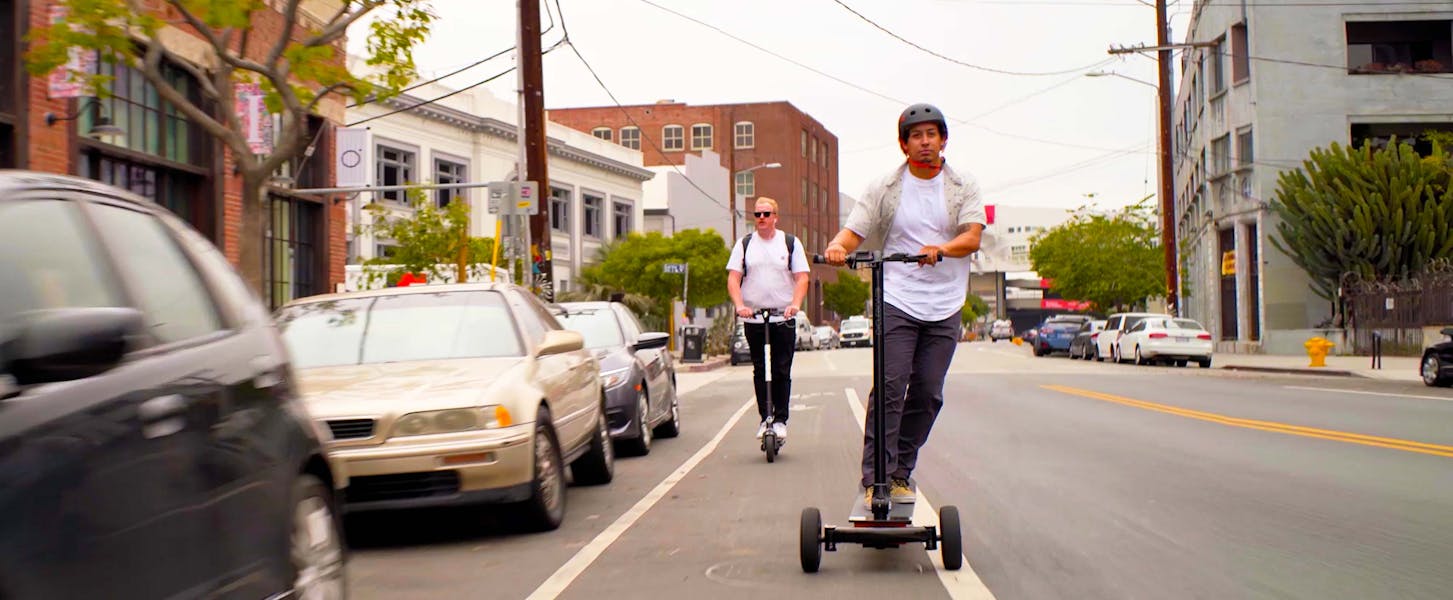
How To Charge Your Electric Scooter: The Complete Guide
Something that seems so simple but is often overlooked is how electric scooters are charged. You may be under the impression that it's as simple as plugging in your scooter overnight, unplugging it in the morning, and heading off on your daily commute. To a certain extent, yes - charging your electric scooter is pretty simple. You just plug your charger into the charging port, give the battery the time it needs to get juiced up, and get back out on the road. But there are a few intricate details you need to keep in mind to effectively and efficiently charge your scooter. Learning how to charge an electric scooter correctly should be something you dedicate a bit of time to before taking your new scooter out on its first whirl. If you don't take this seriously, you'll run the risk of damaging your battery and causing premature failure. With the rising cost of lithium-ion batteries, this is not something you should take lightly. We've got you covered, though. Today, we're going to teach you the correct way to charge your electric scooter. We'll tell you what the manuals fail to mention so that you can enjoy long battery life, quick charge times, and fewer instances of battery replacement. Let's start by discussing what's at stake. What Can Happen With Improper Electric Scooter Charging? The last thing you want is to charge your electric scooter incorrectly and end up compromising on the battery range and battery life. If you don't use the right charger, or you don't charge the battery long enough, both of these issues will eventually come to fruition. You'll find that your battery doesn't last as long as it used to. While your first charge got you a range of 40 miles, you may notice that this figure is starting to drop. Maybe you only get 30 miles now. Or, maybe it's even less. This is caused by improper charging practices. And eventually, the battery will fail altogether if not properly cared for. You'll end up having to replace it - which is not cheap. Sure, over the course of 5-10 years using your electric scooter you might need to replace your battery. Battery replacement isn't unique to e-scooters. All batteries eventually burn out and need to be replaced - the same goes for an actual car battery, a wireless speaker battery, a laptop battery, etc. But getting the most useful life out of your battery possible is still a worthy endeavor. That's why we are here today to share a few tips and tricks that will extend the life of your e-scooter battery. Let's start by addressing how long your battery lasts. How Long Does Your Electric Scooter's Battery Last? This will obviously vary from model to model, and brand to brand. For example, our Cycleboard Rover has a battery range of 40+ miles. But, our Elite Pro scooter only has a 25-mile range. Other manufacturers' scooters will have their own ranges they're rated for. It's important that you know your scooter's battery range. This will help you identify when it's time to charge the scooter. There are other factors that will affect how long your electric scooter battery lasts. Your riding conditions play a part in this. If you're riding your electric scooter on grass or uphill, the battery will have to work harder than it would on smooth pavement. As such, you can expect to lose a bit of battery life. And if you have your scooter pinned to the max speed for 20 straight miles, you'll drain the battery faster than if you were to ride at a more moderate speed. The weather matters, too. You can safely ride Cycleboard electric scooters in both extremely hot and extremely cold temperatures. But, both ends of the spectrum will compromise battery life compared to moderate riding temperatures. And keep in mind - temperatures over 130 degrees Fahrenheit or under 30 degrees Fahrenheit will potentially damage the battery. Here are a few other factors that can affect the range of your scooter: Rider weight Tire pressure Wind resistance Hills/incline When in doubt, you can typically rely on the instruments on your electric scooter. Some electric scooters have an indicator light that will display low battery levels. Better yet, some electric scooters have a "battery gauge" showing you exactly how much range is left at a given time. How To Charge An Electric Scooter: Best Practices In general, we highly encourage riders to top off their electric scooter after each use. Charging electric scooters regularly keeps a full battery. It also eliminates the stress that fully draining a battery can have on the battery itself. This practice will also prevent you from ever having to deal with the stressful situation of a dead battery while you're miles away from home. If this does happen to you, don't stress too much - you can manually kick-push your scooter home. With that said, here are a few recommendations and best practices for charging the most modern electric scooters. Use The Charger Your Manufacturer Provides For Your Specific Battery First and foremost - only use the manufacturer's specific charger when charging your electric scooter. You may find that you actually have a compatible charger at home already that fits your electric scooter's charging port! Even still, we encourage you to keep things brand-specific. Why? Because using the right scooter charger ensures you won't provide too much power to your battery - which could damage it. For example - say your electric scooter has a 40v battery and you try using a charger rated at 60v. This could lead to overcharging of your battery - resulting in damage. What if you lose your charger, though? Still - you must use the correct charger. Don't just head to the store and find any charge that will fit the charging port on your scooter. Instead, head over to your manufacturer's website and buy the correct charger there. Give Your Electric Scooter A Chance To Cool Off So you just got home from a long commute at the end of the day. You should probably get your scooter plugged into your charger immediately, right? Wrong! Trying to charge an electric scooter while it is still hot is not advisable. You need to give your e-scooter a chance to cool off. Charging your battery is going to cause it to heat up as it is - and doing this on an already hot battery can pose problems. Because of this, we recommend you give your scooter at least 15 minutes to cool off after riding it before charging it. And, we recommend waiting at least 15 minutes after charging an electric scooter before turning it on and riding it. Your Electric Scooter Should Be Turned Off While You Charge It This is something that a lot of people don't even think about. They just pull their scooter into the garage, park it, and (after reading the section above) give it a chance to cool off. Then, they come back out and get the charger plugged into the charging port. But did you double-check that your scooter is actually turned off? Attempting to charge an electric scooter while it's still on won't just potentially damage the battery - it can cause electric shocks in the circuit. Always Charge Your Electric Scooter's Battery To Fully Charged (No More, No Less!) You should always strive for a full charge on your electric scooter - no more, no less. Both overcharging and undercharging the scooter can be problematic and compromise the life of your battery. So, how can you tell when your scooter is done charging? Most scooters have a charger light that will aid you in this. For example, the Cycleboard charger light will be red while the board is accepting a charge. When the charger light turns green, the device is fully charged and ready to be unplugged. What If I Haven't Ridden My Electric Scooter In A Few Months? If your scooter has gone through a period of inactivity, it may still have some battery charge left. Nevertheless, we recommend that you top off your battery every month during periods of non-use. This keeps the battery full and healthy. Looking For More Battery Care Info For Your Cycleboard? If you are the proud owner of a Cycleboard all-terrain electric scooter, we encourage you to review our battery care page. You'll learn about the types of batteries we use in these scooters, and the types of chargers you should use for each. We provide visual demonstrations of how to charge your electric scooter - including how to remove the protective cover to gain access to the battery if necessary. This is a great resource for every rider - don't risk improperly caring for your battery! Final Thoughts On How To Charge Electric Scooters While it seems so simple, you now realize that there are a few intricate details when it comes to the charging process. But, you're now equipped with the expertise to correctly charge your electric scooter. By following the advice we've laid out above, you'll be able to prolong the life of your scooter battery. Just remember the following advice: Always use the original charger your scooter came with (or a replacement from the same manufacturer) Give the scooter a chance to turn off before you plug the charger in - and remember to turn the scooter off. Top off the battery level after each use to maintain a full charge rather than letting the battery level drain to empty. Plug the charger into the wall outlet first, then the scooter. Watch for the red light to turn green to indicate a full charge.
Read More →
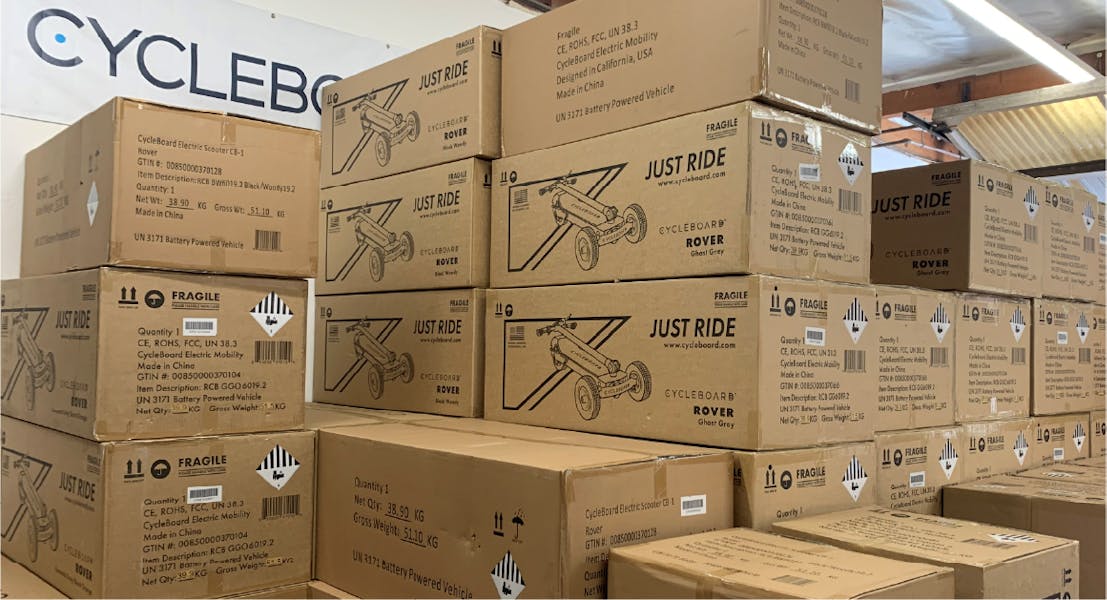
Stocked up and Ready for Summer!
The Rover is in stock and ready to ship. Summer time can't come fast enough! Updates, News, & more... We just got in a new container shipment in of our best selling all-terrain model the CycleBoard Rover. Unfortunately we had a bit of a hiccup with our grip tape supplier and the some of the Rover Boards have been sent to us with defective Grip tapes. But no need to worry, we got you covered! If your board has a defective grip tape, we will include a fresh one at no cost in the box when we ship out your new Board. If you already have a board and are just looking to get some new grip on your deck, then we got you too. Just head on over to our Accessories page, choose your favorite grip tape and we will ship it to you within a few days. Check out the video below to see how you can easily refresh your deck in just a few quick steps: Out of Stock & Other Inventory Updates Below is a list of items that we currently have out of stock in our store and when we expect them to be back in stock, if we have that information. If you have any questions about any items, please email us at support@cycleboard.com • CycleBoard Elite - No ETA • CycleBoard Golf - ETA Mid Summer • Matte Black Cargo Basket - Ships July 30th – Aug. 15th • Front Fender Kit (Elite Pro, Rover, Golf) - Elite Fenders OUT OF STOCK, Rover and Golf Fenders ship in Aug • Handle Bar Headlight | Blaze 400 SLX - the 400SLX is out of stock till mid summer, but we currently have the Blaze 600 SLX in stock now. • Hydraulic Brake Bleed And Repair Kit | All Models - Mid Summer • Front Tire & Wheel | 8.5" X 2.25" | Elite & Elite Pro - OUT OF STOCK - No ETA
Read More →
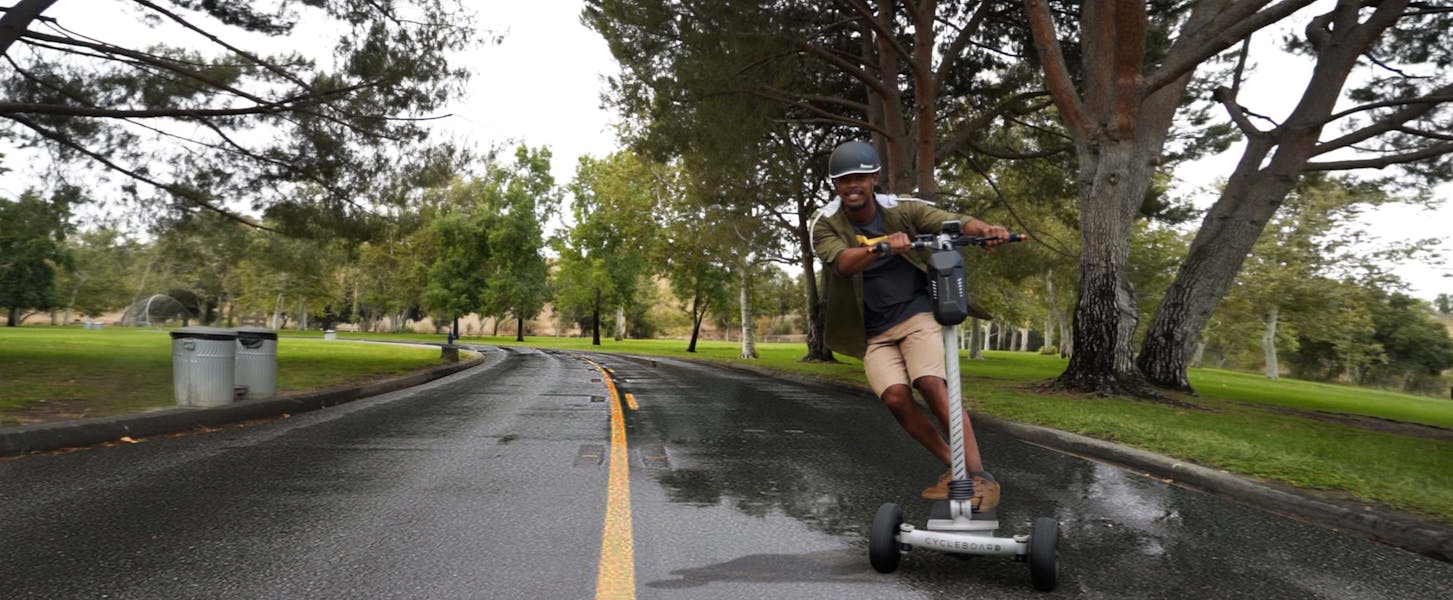
Can Electric Scooters Be Used In The Rain?
Picture this - you use your electric scooter as a daily driver for your commute. But you wake up for work one day and look outside to see it's pouring. This leads you to ask one of the most common questions riders have: can electric scooters be used in the rain? This is a hotly debated topic, and you'll find varying answers online. That's because the answer isn't so simple. All sorts of factors affect whether or not you can safely ride electric scooters in the rain. That's why today we're going to put this topic to rest. We'll cover everything you need to know, including scooter types, weather conditions, and safety concerns. Don't call up that Uber just yet - let's take a look at the main concerns you should take note of when it comes to riding an electric scooter in the rain. Riding Electric Scooters In The Rain - Why Recommendations Are Not One Size Fits All Before we can tell you definitively "yes - you can ride your electric scooter in the rain" or "no - avoid wet conditions", we need to discuss why this topic is so hotly debated. There are many variables at play. First and foremost, electric scooters are not always waterproof. To avoid damage to your scooter, you need to understand if the internal components are protected. Secondly, we need to define "rain" - are you dealing with a full-blown downpour or just some light rain? And will you be riding on the pavement or on a dirt road through the park? Let's discuss. Scooter Types Vary Not all electric scooters are created equal. The type of electric scooter you own will play the biggest role in whether you can safely venture out into wet conditions or not. We'll talk about IP ratings more in-depth shortly, but this is something you need to take into account. You also need to consider other aspects of your scooter that could be compromised in wet conditions, such as your tires or lighting. Here at CycleBoard, we're passionate about safety and stability. Even if your scooter has a waterproof IP rating, you may want to keep it in the garage if your visibility is limited or your tires are slick. Light Rain vs A Full Blown Downpour Of course, another huge variable is the actual conditions outside. Rain is subjective - are you dealing with a light drizzle or a hurricane? Use your best judgment. If a light drizzle is all that stands in your way, you are likely safe to venture out. But, even if your scooter can handle some water, do you really want to ride in miserable conditions? You may be better off calling up an Uber when mother nature shows her fury with an outright downpour of heavy rain - or worse, freezing rain! So - Can Electric Scooters Be Used In The Rain? Now you know the different variables at play here. So, we're finally ready to help you determine whether or not you can ride your electric scooter in the rain. It mostly comes down to how well equipped your scooter is for wet weather. But even if you're riding water-resistant electric scooters, you have to weigh the conditions, too. Let's start with a quick explanation of IP Ratings. How IP Ratings Affect Your Electric Scooters Ability To Traverse Wet Conditions IP - also known as ingress protection - speaks to the degree to which your electric scooter's internal parts are protected from things like dust and water. While you may not have considered this rating when shopping for your electric scooter, it is incredibly important. The last thing you want to do is ride your scooter through dusty or rainy conditions and damage the important internal parts. So, you should do your due diligence into how protected your electric scooter Here are the different IP ratings you may come across on your device: IP 54- limited protection from dust, protected from water splashes from any direction IP 55 - limited protection from dust, protected from low-pressure water jets from any direction IP 56- limited protection from dust, protected from high-pressure water jets from any direction IP 65 - complete protection from dust and low-pressure water jets from any direction IP 66- complete protection from dust and high-pressure water jets from any direction Consider Your Electric Scooter's IP Rating Now that you know the different IP Ratings, it's just a matter of looking up your specific electric scooter. Most quality waterproof electric scooters feature an IP 65 rating to protect from low-pressure water jets from any direction. This would imply that yes - you can ride your electric scooter in the rain. A nice bonus is that it also means cleaning your scooter is easy - it can withstand blasts from a hose! But, even lower IP ratings like IP 56, IP 55, and IP 54 may still be ridden in wet conditions. You just have to carefully assess the conditions themselves. Your scooter will be perfectly safe in light rain. You can even cruise through a few shallow puddles without much worry. However, you should avoid riding through super heavy rain and deep puddles. Are you struggling to find an IP Rating for your scooter? Most electric scooters have one, but not all. If this information isn't made readily available by your scooter manufacturers, it's a red flag. Your scooter likely has no protection from water, and should not be taken out in even light rain. You not only risk damaging the electric scooter itself by riding in the rain. You also run the risk of dealing with an electric shock. Consider Your Electric Scooter's Lighting Ok, so your electric scooter is technically rated for rain - does this mean you're safe to head out in a storm? Not necessarily. You also have to consider visibility. If you are struggling to see more than a few feet in front of you, riding your electric scooter is still considered dangerous, and we'd advise against it. These conditions not only create the risk of you crashing into something or someone. They also create the risk of cars not seeing you on the scooter. Visibility is an important factor that you have to take into account. Ideally, your electric scooter has lights on it. These lights should be bright enough to be seen in the rain. Consider Your Electric Scooter's Board Traction You also need to think about how stable you'll be on the board of your electric scooter in the rain. If you went with the best electric scooter possible, this probably won't be a concern. Take the CycleBoard Rover, for example. This electric scooter features an oversized deck that grants you all the standing room you need. But more importantly, it's equipped with a non-slip grip tape surface for superior foot traction. This will keep you from slipping off at high rates of speed - which, as you can imagine, is very dangerous. Consider Your Electric Scooters Wheels When we talk about the traction of your electric scooter, we also have to discuss the traction your wheels provide. Some waterproof electric scooters don't come with all-terrain wheels. In the right (or perhaps, wrong) conditions, this could lead to hydroplaning your scooter and losing control. Ideally, you would only head out on your electric scooter in the rain if it's equipped with large, all-terrain pneumatic tires. These not only provide a softer ride. They provide a superior grip and traction on mixed terrain and wet surfaces. Do You Absolutely Need To Ride Your Scooter In The Rain? We've talked all about the different factors you need to consider before taking your electric scooter out in the rain. We want to wrap things up and leave you with a few closing thoughts. If you have a waterproof electric scooter - or at least one with the proper IP rating - and it satisfies the other criteria we've laid out, then yes - you can ride your electric scooter in the rain. If you're running late for work and the electric scooter is your only option, you can safely do so. Just exercise extreme caution while riding. Wear highly visible clothing, wear the proper safety equipment (helmet), and ride defensively. No fast accelerations, no quick turns. But, if you have an alternative mode of transportation, and the conditions are more than just light rain, we encourage you to avoid riding your electric scooter. Why venture out in freezing rain if you don't have to? Take the bus, call a friend/Uber, or drive your car. It's simply not worth the risk if you aren't feeling confident in your ability to traverse the conditions. Final Thoughts On Riding Your Electric Scooter In The Rain Can electric scooters be used in the rain? You now know that if you have the right electric scooter, and conditions aren't too severe, then yes - you can. In closing, though, it is up to you to use your best judgment. The more experience you gain in riding your electric scooter, the better understanding you'll have of when it's a good idea to leave the scooter parked in the garage. Are you looking for an electric scooter that is up to the challenge on those wet days? Look no further than the all-terrain electric scooters by CycleBoard. Our entire catalog features an IP 65 rating. This means they're fully protected from dust along with low-pressure water jets from any direction. They also feature heavy-duty, all-terrain tires that perform well on wet pavement or bumpy dirt paths. No matter where your journey takes you, these electric scooters are up to the challenge. With a CycleBoard, you can ride in confidence. We're passionate about safety and stability and have engineered our electric scooter lineup accordingly. And with Affirm, you can get your electric scooter today and pay later on - as low as $119 a month! Head over to the site and see for yourself what makes our water-resistant electric scooters so special.
Read More →
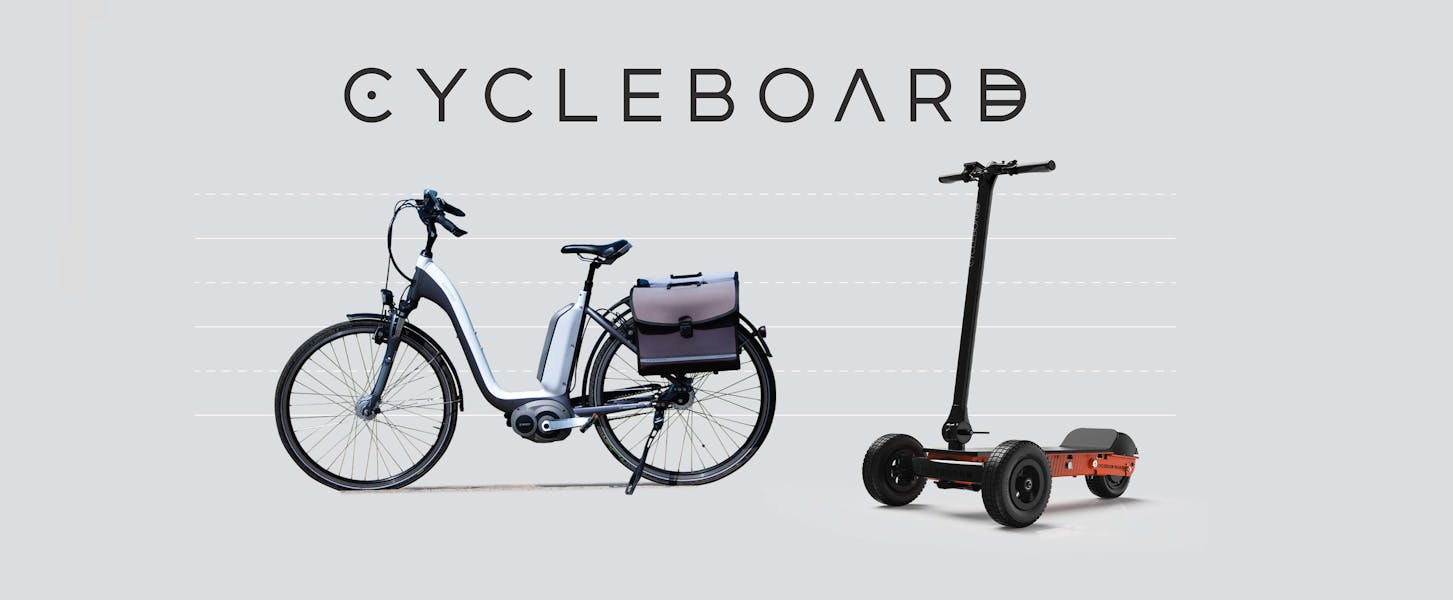
Electric Scooters vs Electric Bikes: Choosing Your Personal Electric Vehicle
So you've made the decision to invest in a personal electric vehicle for daily commuting and weekend fun. Great choice! This will not only save you a ton of money on gas, parking, and the depreciation of your car. But, personal electric vehicles are also better for our planet. The less carbon emitted on the road, the better! But - you've arrived at a crossroads. What type of personal electric vehicle is right for you? You have two main options: electric scooters or electric bikes. While these more or less do the same thing, they are very different. The right choice for you will depend on factors such as your desired use, your budget, and more. To help you make the right decision, we're going to take a deep dive into the difference between an e-bike vs e-scooter. By the end of this article, you'll have a better understanding of which personal electric vehicle is best suited for your needs and preferences. Let's begin with some quick explanations of electric scooters and electric bikes. What Are Electric Scooters? The earliest electric scooter was designed back in 1915 - but these weren't made popular until the mid-90s. These were designed as a fun toy, with every youth in the nation wanting their own e-scooter. But - electric scooters aren't just for kids anymore. These days, an electric scooter is a practical electric vehicle for adults, too. You'll hear these referred to as either e-scooters or motorized scooters, too. They come equipped with either 2 wheels or 3 wheels - with the latter offering more versatility and stability. To operate these, you stand on the platform and use a throttle control on one of the handles. There is typically a break on the other handle. While companies like Bird and Lime have popularized these as rental services in major cities, owning your very own electric scooter offers a myriad of benefits. What Are Electric Bikes? Now that you know what exactly electric scooters are, what are electric bikes? You're no doubt familiar with traditional bikes. These are the exact same thing - but they're powered by an electric motor. Some electric bikes still have pedals on them and can be considered "hybrid bikes" that are capable of being powered by pedaling or the motor. Electric bikes are great for those who have a long commute and don't want to get hot and sweaty on their way to work by pedaling a traditional bike. But, are electric bikes better than electric scooters? What are the differences between these personal electric vehicles? Without any further ado, let's compare and contrast the two so you can gain a better understanding of which one is right for you. Electric Scooter vs Electric Bike: Differences Between These Personal Electric Vehicles The decision between an e-bike vs e-scooter will come down to a balance of personal preference and your specific needs. While electric scooters are certainly more fun and versatile than electric bikes, you'll have to consider other factors like battery range, comfort, cost, and more. Don't worry - we're going to look at the most important criteria you must consider in your own shopping journey. Let's get started by talking about everyone's favorite features on electric scooters and electric bikes: speed and acceleration. Top Speed While these personal electric vehicles won't hit a top speed over 100 as your car might, they're pretty quick these days. In fact, e-bikes and e-scooters alike can reach top speeds of up to 30MPH! This of course depends on your battery level and the specific manufacturer/model you go with. But now comes the big question - which is faster? In general, electric bikes have a higher top speed. In some cases, they can even exceed 30MPH. Most electric scooters, on the other hand, cap out at less than 25MPH. With that said, certain electric scooters can reach a top speed of 27MPH. As such, this is a minor difference. But when you have a long commute of 10+ miles - every bit counts. However, we want to warn you against shopping based solely on speed. The top speed matters far less if you're commuting around city streets and frequently have to maneuver around other bikes, cars, pedestrians, and stop lights/stop signs. Take into account how much smaller and more nimble the average electric scooter is. With an e-bike, you're forced to slow down and potentially come to a halt as you wait for other people to get out of your way. With an e-scooter, you'll zip around with ease. With that said, those riding in rural areas with minimal city traffic will gain the benefit of a higher rate of speed that the e-bike offers. Consider how you'll use the scooter when evaluating the need for speed. Battery Range/Capacity If you plan to use your electric scooter or electric bike as your daily driver to and from work, then speed may not even be the most important factor: battery range. If you have an 8-mile commute, that means you need a form of personal electric transportation rated for well over 16 miles to be safe. But the more battery capacity, the better. With a longer battery range, you won't have to plug your e-bike or e-scooter in every single night when you get home. And in general, electric bikes have more battery range than electric scooters. Some electric scooters come equipped with long-lasting batteries that can get you 40 miles worth of range. Conversely, there are e-bikes that boast a battery range of over 70 miles. However, you have to ask yourself - what makes e-bikes so much more efficient in terms of battery capacity? Most of the time, the e-bikes that boast a crazy range like this are the hybrid style we mentioned earlier. While they are electric, they'll require you to aid in pedaling. Pedal assist may not be something you mind - after all, working up a little sweat never hurt. But let's face it - nobody wants to step into work stinking and displaying pit stains or back sweat. Comfortable Ride You should also consider what is more comfortable for you - sitting or standing. While many e-scooters can be outfitted with a seat, this is not the standard. Most electric scooters are stand-up rides. E-bikes, on the other hand, come equipped with a seat. In our opinion, getting the opportunity to stand while commuting to and from work is a huge benefit of e-scooters. If you work in the city, you probably sit at a desk all day. This sitting can take a serious toll on your hips, knees, and back. Standing for 30-60 minutes a day will help loosen up that tension you develop while sitting at work. Thus, the electric scooter has an advantage in comfort and ergonomics. But, you also need to consider the suspension of your personal electric transportation device. The average electric bike doesn't come with suspension - these are street bikes, so to speak. Potholes and bumps in the road will take their toll over time. Many electric scooters, on the other hand, come equipped with heavy-duty suspension. You'll feel like you're gliding on air while cruising the streets in your electric scooter. All this considered, we prefer the comfortable ride an e-scooter provides vs the more rigid, seated ride an e-bike offers. Convenience & Portability The convenience and portability e-scooters offer simply cannot be beaten by e-bikes. An electric bike is far larger and bulkier - and thus, will take up more space in your garage. Not only that - but you'll have to park it outside if you aren't on the first floor of your building. E-scooters, on the other hand, are highly portable. They can be broken down and folded up. This makes it easy to carry the e-scooter upstairs or put it in the trunk of your car if you're taking a trip. While the typical electric scooter weighs under 30 pounds, an electric bike can weigh up to 100 pounds! Good luck lugging that thing around your apartment building or office space. It's also worth noting that there will be instances where you'll use your e-scooter or e-bike as temporary transportation to get you to your train station. Again - the portability of an e-scooter will really come in handy here. You can even call up a taxi if it's looking like you forgot to charge up your e-scooter and plop it in the trunk of the taxi. With an e-bike, you'll be stuck pedaling manually the rest of the way. Safety Features & Concerns One aspect that often gets overlooked in the electric scooter vs electric bike debate is safety. When you ride them carefully, both of these are perfectly safe means of transportation. But is one safer than the other? People generally regard e-scooters as a bit less safe than e-bikes. Why is that? It comes down to two reasons. First and foremost, some people ride their e-scooters a bit more aggressively than they would an e-bike. That's because e-scooters are designed not just to get you from point a to point b - but to allow you to have fun doing it. As such, you may find yourself getting a bit carried away on e-scooters. E-bike riders are typically more careful - and just use electric bicycles as a way to get to and from their destination. But it's also in the design. E-scooters are lower to the ground, and if you aren't an experienced rider - you can be more prone to losing control or balance. This is less of an issue when you buy three-wheeled electric scooters. While these are not as common as their two-wheeled counterparts, they are quickly becoming regarded as the preferred choice among riders. They offer far more stability and control, and thus, keep you safer. You should also factor in the wheels of your e-scooter or e-bike. An e-bike is sometimes regarded as safer because the tires are much larger. However, you can easily find an e-scooter with large pneumatic tires, too. Another thing to keep in mind is the brakes on your device. For example, e-scooters these days come with electronic braking that helps you stop on a dime. With all this said, safety is a bit of a wash in the e-scooter vs e-bike debate. Cost You're probably going to greatly consider the cost of an electric scooter vs an electric bike before making a decision. Keep in mind that shopping based on price isn't the best idea - you typically get what you pay for. Trying to save some money with a cheaper electric vehicle will only cost you more in the long run as you have to shell out for repairs or a replacement vehicle altogether. With that said, a high-quality e-scooter is far cheaper than a high-quality e-bike. When comparing the best in each class, you'll save much more money by opting for the electric scooter. You can get the best of the best for under $3k. On the other hand, a high-end e-bike can cost as much as $5K+! If you're looking to get the most out of your budget, e-scooters tend to be the right choice. Keep in mind - you have to get the best electric scooter possible if you're looking to gain the most value. Fortunately, we wrote up a guide to help you make your choice. Fun & Versatility Sure - you want your e-scooter or e-bike to get you from point a to point b. But why not have some fun doing it? The reality is that an electric scooter is much more fun than an electric bike - plain and simple. To truly understand why you'd have to experience the sheer thrill of carving up a road on your electric scooter. It's unlike anything an e-bike can provide. Furthermore, off-road e-scooters allow you to ride in any terrain. You can ride electric scooters on grass, on dirt paths, on the beach, you name it. Compared to the road-locked e-bike, an e-scooter is far more versatile. If you identify a shortcut on your way to work that takes you off the beaten path, you'll be able to take it - not a problem. However, most e-bikes are built for the street and the street only. Electric Scooter vs Electric Bike: The Final Verdict Well, that just about wraps up our electric scooter vs electric bike debate. At this point, all that's left to do is weigh the pros and cons each means of transportation provides. The average e-bike will get you to and from work safely, and an electric scooter can do that too - but while offering more fun along the way. As such, most people prefer electric scooters. However, only you can decide which is right for you. If you're looking to learn more about electric 3-wheeled scooters, head over to the Cycleboard site and discover what makes us the right choice for your transportation needs.
Read More →
Page 1 of 3 Next page →





